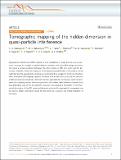Files in this item
Tomographic mapping of the hidden dimension in quasi-particle interference
Item metadata
| dc.contributor.author | De Almeida Marques, Carolina | |
| dc.contributor.author | Bahramy, Saeed | |
| dc.contributor.author | Trainer, Christopher | |
| dc.contributor.author | Markovic, Igor | |
| dc.contributor.author | Watson, Matthew David | |
| dc.contributor.author | Mazzola, Federico | |
| dc.contributor.author | Rajan, Akhil | |
| dc.contributor.author | Raub, Timothy David | |
| dc.contributor.author | King, Phil | |
| dc.contributor.author | Wahl, Peter | |
| dc.date.accessioned | 2021-11-18T15:30:01Z | |
| dc.date.available | 2021-11-18T15:30:01Z | |
| dc.date.issued | 2021-11-18 | |
| dc.identifier | 273736835 | |
| dc.identifier | 051f5dc4-8714-4277-bc12-e4601aaffb26 | |
| dc.identifier | 85119263034 | |
| dc.identifier | 000720682300048 | |
| dc.identifier.citation | De Almeida Marques , C , Bahramy , S , Trainer , C , Markovic , I , Watson , M D , Mazzola , F , Rajan , A , Raub , T D , King , P & Wahl , P 2021 , ' Tomographic mapping of the hidden dimension in quasi-particle interference ' , Nature Communications , vol. 12 , 6739 . https://doi.org/10.1038/s41467-021-27082-1 | en |
| dc.identifier.issn | 2041-1723 | |
| dc.identifier.other | ORCID: /0000-0003-4513-2245/work/103511061 | |
| dc.identifier.other | ORCID: /0000-0002-8635-1519/work/103511064 | |
| dc.identifier.other | ORCID: /0000-0002-1631-9556/work/103511129 | |
| dc.identifier.other | ORCID: /0000-0002-0737-2814/work/103511149 | |
| dc.identifier.other | ORCID: /0000-0001-5356-3032/work/103511157 | |
| dc.identifier.uri | https://hdl.handle.net/10023/24359 | |
| dc.description | Funding: C.A.M. acknowledges funding from EPSRC through EP/L015110/1, and C.T. and P.W. through EP/R031924/1. P.W. and T.R. are grateful for support through SARIRF funding by the University of St Andrews. I.M. acknowledges studentship support through the International Max Planck Research School for Chemistry and Physics of Quantum Materials. M.D.W., A.R., and P.D.C.K. acknowledge funding from The Leverhulme Trust. F.M. and P.D.C.K. acknowledge funding from the European Research Council (through the ERC-714193-QUESTDO project). F.M. and P.D.C.K. are grateful for support by the project CALIPSOplus under Grant Agreement 730872 from the EU Framework Programme for Research and Innovation HORIZON 2020. P.D.C.K. acknowledges support from the UK Royal Society. | en |
| dc.description.abstract | Quasiparticle interference (QPI) imaging is well established to study the low-energy electronic structure in strongly correlated electron materials with unrivalled energy resolution. Yet, being a surface-sensitive technique, the interpretation of QPI only works well for anisotropic materials, where the dispersion in the direction perpendicular to the surface can be neglected and the quasiparticle interference is dominated by a quasi-2D electronic structure. Here, we explore QPI imaging of galena, a material with an electronic structure that does not exhibit pronounced anisotropy. We find that the quasiparticle interference signal is dominated by scattering vectors which are parallel to the surface plane however originate from bias-dependent cuts of the 3D electronic structure. We develop a formalism for the theoretical description of the QPI signal and demonstrate how this quasiparticle tomography can be used to obtain information about the 3D electronic structure and orbital character of the bands. | |
| dc.format.extent | 8 | |
| dc.format.extent | 6856859 | |
| dc.language.iso | eng | |
| dc.relation.ispartof | Nature Communications | en |
| dc.subject | QC Physics | en |
| dc.subject | TK Electrical engineering. Electronics Nuclear engineering | en |
| dc.subject | DAS | en |
| dc.subject.lcc | QC | en |
| dc.subject.lcc | TK | en |
| dc.title | Tomographic mapping of the hidden dimension in quasi-particle interference | en |
| dc.type | Journal article | en |
| dc.contributor.sponsor | EPSRC | en |
| dc.contributor.sponsor | Scottish Funding Council | en |
| dc.contributor.sponsor | Scottish Funding Council | en |
| dc.contributor.sponsor | European Research Council | en |
| dc.contributor.sponsor | The Leverhulme Trust | en |
| dc.contributor.sponsor | The Royal Society | en |
| dc.contributor.institution | University of St Andrews. School of Physics and Astronomy | en |
| dc.contributor.institution | University of St Andrews. Centre for Designer Quantum Materials | en |
| dc.contributor.institution | University of St Andrews. Condensed Matter Physics | en |
| dc.contributor.institution | University of St Andrews. St Andrews Centre for Exoplanet Science | en |
| dc.contributor.institution | University of St Andrews. School of Earth & Environmental Sciences | en |
| dc.identifier.doi | 10.1038/s41467-021-27082-1 | |
| dc.description.status | Peer reviewed | en |
| dc.identifier.grantnumber | EP/R031924/1 | en |
| dc.identifier.grantnumber | N/A | en |
| dc.identifier.grantnumber | N/A | en |
| dc.identifier.grantnumber | 714193 | en |
| dc.identifier.grantnumber | 2016-006 | en |
| dc.identifier.grantnumber | URF/R/180026 | en |
This item appears in the following Collection(s)
Items in the St Andrews Research Repository are protected by copyright, with all rights reserved, unless otherwise indicated.

